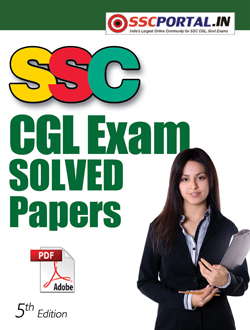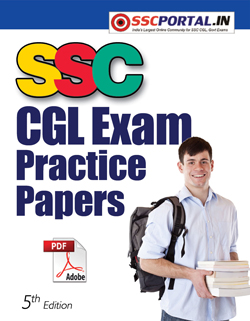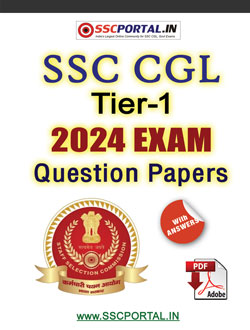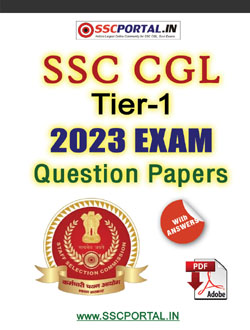NEW! SSC CGL PDF NOTES
(Notification) SSC Combined Graduate Level (CGL) Exam - 2022
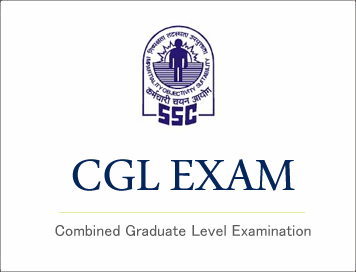
(Notification) SSC Combined Graduate Level (CGL) Exam - 2022
F. No. HQ-PPI03/11/2022-PP_1: Staff Selection Commission will hold Combined Graduate Level Examination, 2022 for filling up of various Group ‘B’ and Group ‘C’ posts in different Ministries/ Departments/ Organizations of Government of India and various Constitutional Bodies/ Statutory Bodies/ Tribunals, etc. The details of the examination are as follows:
Details of the Posts:
Followings are the likely posts that will be filled up through this Examination:
|
2.1 Pay Level-8 (₹ 47600 to 151100): |
||||
|
S No |
Name of Post |
Ministry/ Department/ Office/ Cadre |
Classification of Posts |
Age Limit |
|
1 |
Assistant Audit Officer |
Indian Audit & Accounts Department under C&AG |
Group “B” Gazetted (Non Ministerial) |
Not exceeding 30 years. |
|
2 |
Assistant Accounts Officer |
Indian Audit & Accounts Department under C&AG |
Group “B” Gazetted (Non Ministerial) |
Not exceeding 30 years. |
|
2.2 Pay Level-7 (₹ 44900 to 142400): |
||||
|
3 |
Assistant Section Officer |
Central Secretariat Service |
Group “B” |
20-30 years |
|
4 |
Assistant Section Officer |
Intelligence Bureau |
Group “B” |
Not exceeding 30 years. |
|
5 |
Assistant Section Officer |
Ministry of Railway |
Group “B” |
20-30 years |
|
6 |
Assistant Section Officer |
Ministry of External Affairs |
Group “B” |
20-30 years |
|
7 |
Assistant Section Officer |
AFHQ |
Group “B” |
20-30 years |
|
8 |
Assistant Section Officer |
Ministry of Electronics and Information Technology |
Group “B” |
Not exceeding 30 years. |
|
9 |
Assistant / Assistant Section Officer |
Other Ministries/ Departments/ Organizations |
Group “B” |
Not exceeding 30 years. |
|
10 |
Inspector of Income Tax |
CBDT |
Group “C” |
Not exceeding 30 years |
|
11 |
Inspector, (Central Excise) |
CBIC |
Group “B” |
Not exceeding 30 years |
|
12 |
Inspector (Preventive Officer) |
|||
|
13 |
Inspector (Examiner) |
|||
|
14 |
Assistant Enforcement Officer |
Directorate of Enforcement, Department of Revenue |
Group “B” |
Up to 30 years |
|
15 |
Sub Inspector |
Central Bureau of Investigation |
Group “B” |
20-30 years |
|
16 |
Inspector Posts |
Department of Post, Ministry of Communication |
Group “B” |
Not exceeding 30 years |
|
17 |
Inspector |
Central Bureau of Narcotics, Ministry of Finance |
Group “B” |
Not exceeding 30 years |
|
2.3 Pay Level-6 (₹ 35400 to 112400): |
||||
|
18 |
Assistant |
Other Ministries/ Departments/ Organizations |
Group “B” |
Not exceeding 30 years |
|
19 |
Divisional Accountant |
Offices under C&AG |
Group “B” |
Not exceeding 30 years |
|
20 |
Sub Inspector |
National Investigation Agency (NIA) |
Group “B” |
Up to 30 years |
|
21 |
Sub-Inspector/Junior Intelligence Officer |
Narcotics Control Bureau (MHA) |
Group “B” |
Not exceeding 30 years |
|
22 |
Junior Statistical Officer |
Ministry of Statistics &Programme Implementation. |
Group “B” |
Up to 32 years |
|
2.4 Pay Level-5 (₹ 29200 to 92300): |
||||
|
23 |
Auditor |
Offices under C&AG |
Group “C” |
18-27 years |
|
24 |
Auditor |
Offices under CGDA |
Group “C” |
18-27 years |
|
25 |
Auditor |
Other Ministry/ Departments |
Group “C” |
18-27 years |
|
26 |
Accountant |
Offices under C&AG |
Group “C” |
18-27 years |
|
27 |
Accountant |
Controller General of Accounts |
Group “C” |
18-27 years |
|
28 |
Accountant/ Junior Accountant |
Other Ministry/ Departments |
Group “C” |
18-27 years |
|
2.5 Pay Level-4 (₹ 25500 to 81100): |
||||
|
29 |
Postal Assistant/ Sorting Assistant |
Department of Post, Ministry of Communication |
Group “C” |
18-27 years |
|
30 |
Senior Secretariat Assistant/ Upper Division Clerks |
Central Govt. Offices/ Ministries other than CSCS cadres. |
Group “C” |
18-27 years |
|
31 |
Senior Administrative Assistant |
Military Engineering Services, Ministry of Defence |
Group “C” |
18-27 years |
|
32 |
Tax Assistant |
CBDT |
Group “C” |
18-27 years |
|
33 |
Tax Assistant |
CBIC |
Group “C” |
18-27 years |
|
34 |
Sub-Inspector |
Central Bureau of Narcotics, Ministry of Finance |
Group “C” |
18-27 years |
|
35 |
Upper Division Clerks |
Dte. Gen Border Road Organisation (MoD)
(Post is only for male Candidates with higher physical and medical standards given at Annexure-XVIII) |
Group “C” |
18-27 years |
Study Material for Combined Graduate Level Examination
EDUCATIONAL QUALIFICATION : ( As on 08.10.2022)
Assistant Audit Officer/Assistant Accounts Officer:
- Essential Qualifications: Bachelor’s Degree from a recognized University or Institute.
- Desirable Qualifications: Chartered Accountant or Cost & Management Accountant or Company Secretary or Masters in Commerce or Masters in Business Studies or Masters in Business Administration (Finance) or Masters in Business Economics.
- During the period of probation direct recruits shall have to qualify the “Subordinate Audit/ Accounts Service Examination” in respective branches for confirmation and regular appointment as Assistant Audit Officer/Assistant Accounts Officer.
Junior Statistical Officer:
- Bachelor’s Degree in any subject from a recognized University or Institute with at least 60% Marks in Mathematics at 12th standard level;
Or
- Bachelor’s Degree in any subject with Statistics as one of the subjects at degree level.
All other Posts:
- Bachelor’s Degree from a recognized University or equivalent.
The candidates who have appeared in their final year of their graduation can also apply, however they must possess Essential qualification on or before the cut-off date i.e.08-10-2022.
AGE LIMIT (As on 01-01-2022):
Requirement of age for various posts is as follows:
|
S No |
Age Limit |
Remarks |
|
(i) |
For the posts for which age limit is 18-27 years |
Candidate must have been born not earlier than 02-01-1995 and not later than 01-01-2004. |
|
(ii) |
For the posts for which age limit is 20-30 years |
Candidate must have been born not earlier than 02-01-1992 and not later than 01-01-2002. |
|
(iii) |
For the posts for which age limit is18-30 years |
Candidate must have been born not earlier than 02-01-1992 and not later than 01-01-2004. |
|
(iv) |
For the post for which age limit is18-32 years |
Candidate must have been born not earlier than 02-01-1990 and not later than 01-01-2004. |
Permissible relaxation in upper age limit and category-codes for claiming age relaxation are as follows:
|
Code No |
Category |
Age-relaxation permissible beyond upper age limit |
|
01 |
SC/ST |
5 years |
|
02 |
OBC |
3 years |
|
03 |
PwD (Unreserved) |
10 years |
|
04 |
PwD (OBC) |
13 years |
|
05 |
PwD (SC/ST) |
15 years |
|
06 |
Ex-Servicemen (ESM) |
3 years after deduction of the military service rendered from the actual age as on the closing date. |
|
08 |
Defence Personnel disabled in operation during hostilities with any foreign country or in a disturbed area and released as a consequence thereof |
3 years |
|
09 |
Defence Personnel disabled in operation during hostilities with any foreign country or in a disturbed area and released as a consequence thereof (SC/ST) |
8 years |
|
Additional permissible relaxation in upper age limit for Group ‘C’ posts |
||
|
10 |
Central Govt. Civilian Employees who have rendered not less than 3 years regular and continuous service as on closing date for receipt of application. |
Upto 40 years of age |
|
11 |
Central Govt. Civilian Employees(SC/ST) who have rendered not less than 3 years regular and continuous service as on closing date for receipt of application. |
Upto 45 years of age |
|
12 |
Widows/ Divorced Women/ Women judicially separated and who are not remarried. |
Up to 35 years of age |
|
13 |
Widows/ Divorced Women/ Women judicially separated and who are not remarried (SC/ST). |
Up to 40 years of age |
Exam Syllabus And Scheme of The Examination :
13.9.1 Tier-I: General Intelligence & Reasoning: It would include questions of both verbal and non-verbal type. This component may include questions on analogies, similarities and differences, space visualization, spatial orientation, problem solving, analysis, judgment, decision making, visual memory, discrimination, observation, relationship concepts, arithmetical reasoning and figural classification, arithmetic number series, non-verbal series, coding and decoding, statement conclusion, syllogistic reasoning etc. The topics are, Semantic Analogy, Symbolic/Number Analogy, Figural Analogy, Semantic Classification, Symbolic/Number Classification, Figural Classification, Semantic Series, Number Series, Figural Series, Problem Solving, Word Building, Coding & de-coding, Numerical Operations, symbolic Operations, Trends, Space Orientation, Space Visualization, Venn Diagrams, Drawing inferences, Punched hole/ pattern- folding& un-folding, Figural Pattern-folding and completion, Indexing, Address matching, Date & city matching, Classification of centre codes/roll numbers, Small & Capital letters/numbers coding, decoding and classification, Embedded Figures, Critical thinking, Emotional Intelligence, Social Intelligence.
13.9.2 General Awareness: Questions in this component will be aimed at testing the candidates’ general awareness of the environment around him and its application to society. Questions will also be designed to test knowledge of current events and of such matters of every day observations and experience in their scientific aspect as may be expected of any educated person. The test will also include questions relating to India and its neighbouring countries especially pertaining History, Culture, Geography,Economic Scene, General Policy & Scientific Research.
13.9.3 Quantitative Aptitude: The questions will be designed to test the ability of appropriate use of numbers and number sense of the candidate. The scope of the test will be computation of whole numbers, decimals, fractions and relationships between numbers, Percentage. Ratio & Proportion, Square roots, Averages, Interest, Profit and Loss, Discount, Partnership Business, Mixture and Alligation, Time and distance, Time & Work, Basic algebraic identities of School Algebra & Elementary surds, Graphs of Linear Equations, Triangle and its various kinds of centres, Congruence and similarity of triangles, Circle and its chords, tangents, angles subtended by chords of a circle, common tangents to two or more circles, Triangle, Quadrilaterals, Regular Polygons, Circle, Right Prism, Right Circular Cone, Right Circular Cylinder, Sphere, Hemispheres, Rectangular Parallelepiped, Regular Right Pyramid with triangular or square base, Trigonometric ratio, Degree and Radian Measures, Standard Identities, Complementary angles, Heights and Distances, Histogram, Frequency polygon, Bar diagram & Pie chart.
13.9.4 English Comprehension: Candidates’ ability to understand correct English, his basic comprehension and writing ability, etc. would be tested.
13.9.5 The questions in Parts A, B, & D will be of a level commensurate with the essential qualification viz. Graduation and questions in Part-C will be of 10th standard level.
13.10 Indicative Syllabus (Tier-II):
13.10.1 Module-I of Session-I of Paper-I (Mathematical Abilities):
13.10.1.1 Number Systems: Computation of Whole Number, Decimal and Fractions, Relationship between numbers.
13.10.1.2 Fundamental arithmetical operations: Percentages, Ratio and Proportion, Square roots, Averages, Interest (Simple and Compound), Profit and Loss, Discount, Partnership Business, Mixture and Alligation, Time and distance, Time and work.
13.10.1.3 Algebra: Basic algebraic identities of School Algebra and Elementary surds (simple problems) and Graphs of Linear Equations.
13.10.1.4 Geometry: Familiarity with elementary geometric figures and facts:
Triangle and its various kinds of centres, Congruence and similarity of triangles, Circle and its chords, tangents, angles subtended by chords of a circle, common tangents to two or more circles.
13.10.1.5 Mensuration: Triangle, Quadrilaterals, Regular Polygons, Circle, Right Prism, Right Circular Cone, Right Circular Cylinder, Sphere, Hemispheres, Rectangular Parallelepiped, Regular Right Pyramid with triangular or square Base.
13.10.1.6 Trigonometry: Trigonometry, Trigonometric ratios, Complementary angles, Height and distances (simple problems only) Standard Identities like sin2� + cos2�=1 etc.
13.10.1.7 Statistics and probability: Use of Tables and Graphs: Histogram, Frequency polygon, Bar-diagram, Pie-chart; Measures of central
tendency: mean, median, mode, standard deviation; calculation of simple probabilities.
13.10.2 Module-II of Section-I of Paper-I (Reasoning and General Intelligence):
13.10.2.1 Questions of both verbal and non-verbal type. These will include questions on Semantic Analogy, Symbolic operations, Symbolic/ Number Analogy, Trends, Figural Analogy, Space Orientation, Semantic Classification, Venn Diagrams, Symbolic/ Number Classification, Drawing inferences, Figural Classification, Punched hole/ pattern-folding & unfolding, Semantic Series, Figural Patternfolding and completion, Number Series, Embedded figures, Figural Series, Critical Thinking, Problem Solving, Emotional Intelligence, Word Building, Social Intelligence, Coding and de-coding, Numerical operations, Other sub-topics, if any.
13.10.3 Module-I of Section-II of Paper-I (English Language And Comprehension):
13.10.3.1 Vocabulary, grammar, sentence structure, synonyms, antonyms and their correct usage; Spot the Error, Fill in the Blanks, Synonyms/ Homonyms, Antonyms, Spellings/ Detecting mis-spelt words, Idioms & Phrases, One word substitution, Improvement of Sentences, Active/ Passive Voice of Verbs, Conversion into Direct/ Indirect narration, Shuffling of Sentence parts, Shuffling of Sentences in a passage, Cloze Passage, Comprehension Passage. To test comprehension, three or more paragraphs will be given and questions based on those will be asked. At least one paragraph should be a simple one based on a book or a story and the other two paragraphs should be on current affairs, based on a report or an editorial.
13.10.4 Module-II of Section-II of Paper-I (General Awareness):
13.10.4.1 Questions are designed to test the candidates’ general awareness of the environment around them and its application to society. Questions are also designed to test knowledge of current events and of such matters of everyday observation and experience in their scientific aspect as may be expected of an educated person. The test will also include questions relating to India and its neighboring countries especially pertaining to History, Culture, Geography, Economic Scene, General policy and scientific research.
13.10.5 Module-I of Section-III of Paper-I (Computer Proficiency):
13.10.5.1 Computer Basics: Organization of a computer, Central Processing Unit (CPU), input/ output devices, computer memory, memory organization, back- up devices, PORTs, Windows Explorer. Keyboard shortcuts.
13.10.5.2 Software: Windows Operating system including basics of Microsoft Office like MS word, MS Excel and Power Point etc..
13.10.5.3 Working with Internet and e-mails: Web Browsing & Searching,Downloading & Uploading, Managing an E-mail Account, e-Banking.
13.10.5.4 Basics of networking and cyber security: Networking devices and protocols, Network and information security threats (like hacking, virus, worms, Trojan etc.) and preventive measures.
13.10.6 Paper-II (Statistics):
13.10.6.1 Collection, Classification and Presentation of Statistical Data –Primary and Secondary data, Methods of data collection; Tabulation of data; Graphs and charts; Frequency distributions; Diagrammatic presentation of frequency distributions.
13.10.6.2 Measures of Central Tendency- Common measures of central tendency – mean median and mode; Partition values- quartiles, deciles, percentiles.
13.10.6.3 Measures of Dispersion- Common measures dispersion – range,quartile deviations, mean deviation and standard deviation; Measures of relative dispersion.
13.10.6.4 Moments, Skewness and Kurtosis – Different types of moments and their relationship; meaning of skewness and kurtosis; different measures of skewness and kurtosis.
13.10.6.5 Correlation and Regression – Scatter diagram; simple correlation coefficient; simple regression lines; Spearman’s rank correlation; Measures of association of attributes; Multiple regression; Multiple and partial correlation (For three variables only).
13.10.6.6 Probability Theory – Meaning of probability; Different definitions of probability; Conditional probability; Compound probability; Independent events; Bayes’ theorem.
13.10.6.7 Random Variable and Probability Distributions – Random variable; Probability functions; Expectation and Variance of a random variable; Higher moments of a random variable; Binomial, Poisson, Normal and Exponential distributions; Joint distribution of two random variable (discrete).
13.10.6.8 Sampling Theory – Concept of population and sample; Parameter and statistic, Sampling and non-sampling errors; Probability and nonprobability sampling techniques (simple random sampling, stratified sampling, multistage sampling, multiphase sampling, cluster sampling, systematic sampling, purposive sampling, convenience sampling and quota sampling); Sampling distribution(statement only); Sample size decisions.
13.10.6.9 Statistical Inference - Point estimation and interval estimation, Properties of a good estimator, Methods of estimation (Moments method, Maximum likelihood method, Least squares method), Testing of hypothesis, Basic concept of testing, Small sample and large sample tests, Tests based on Z, t, Chi-square and F statistic, Confidence intervals.
13.10.6.10 Analysis of Variance - Analysis of one-way classified data and twoway classified data.
13.10.6.11 Time Series Analysis - Components of time series, Determinations of trend component by different methods, Measurement of seasonal variation by different methods.
13.10.6.12 Index Numbers - Meaning of Index Numbers, Problems in the construction of index numbers, Types of index number, Different formulae, Base shifting and splicing of index numbers, Cost of living Index Numbers, Uses of Index Numbers.
Paper-III (General Studies-Finance and Economics):
13.10.7.1 Part A: Finance and Accounts-(80 marks):
13.10.7.1.1 Fundamental principles and basic concept of Accounting:
13.10.7.1.1.1 Financial Accounting: Nature and scope, Limitations of Financial Accounting, Basic concepts and Conventions, Generally Accepted Accounting Principles.
13.10.7.1.1.2 Basic concepts of accounting: Single and double entry,Books of original Entry, Bank Reconciliation, Journal, ledgers, Trial Balance, Rectification of Errors, Manufacturing, Trading, Profit & loss Appropriation Accounts, Balance Sheet Distinction between Capital and Revenue Expenditure, Depreciation Accounting, Valuation of Inventories, Non-profit organisations Accounts, Receipts and Payments and Income & Expenditure Accounts, Bills of Exchange, Self Balancing Ledgers.
Part B: Economics and Governance-(120 marks):
13.10.7.2.1 Comptroller & Auditor General of India -Constitutional provisions, Role and responsibility.
13.10.7.2.2 Finance Commission-Role and functions.
13.10.7.2.3 Basic Concept of Economics and introduction to Micro Economics: Definition, scope and nature of Economics, Methods of economic study and Central problems of an economy and Production possibilities curve.
13.10.7.2.4 Theory of Demand and Supply: Meaning and determinants of demand, Law of demand and Elasticity of demand, Price, income and cross elasticity; Theory of consumer’s behaviourMarshallian approach and Indifference curve approach, Meaning and determinants of supply, Law of supply and Elasticity of Supply.
13.10.7.2.5 Theory of Production and cost: Meaning and Factors of production; Laws of production- Law of variable proportions and Laws of returns to scale.
13.10.7.2.6 Forms of Market and price determination in different markets: Various forms of markets-Perfect Competition, Monopoly, Monopolistic Competition and Oligopoly and Price determination in these markets.
Indian Economy:
13.10.7.2.7.1 Nature of the Indian Economy Role of different sectorsRole of Agriculture, Industry and Services-their problems and growth;
13.10.7.2.7.2 National Income of India-Concepts of national income, Different methods of measuring national income.
13.10.7.2.7.3 Population-Its size, rate of growth and its implication on economic growth.
13.10.7.2.7.4 Poverty and unemployment- Absolute and relative poverty, types, causes and incidence of unemployment.
13.10.7.2.7.5 Infrastructure-Energy, Transportation, Communication.
13.10.7.2.8 Economic Reforms in India: Economic reforms since 1991;Liberalisation, Privatisation, Globalisation and Disinvestment.
Money and Banking:
13.10.7.2.9.1 Monetary/ Fiscal policy- Role and functions of Reserve Bank of India; functions of commercial Banks/RRB/Payment Banks.
13.10.7.2.9.2 Budget and Fiscal deficits and Balance of payments.
13.10.7.2.9.3 Fiscal Responsibility and Budget Management Act, 2003.
13.10.7.2.10 Role of Information Technology in Governance.
13.10.8 Questions in Module-I of Section- I of Paper-I (Mathematical Abilities) will be of Matriculation Level, in Module-I of Section- II of Paper-I (English Language and Comprehension) of 10+2 Level and in Paper-II and
Paper-III of Graduation Level.
Scheme of Tier-I Examinations:
|
Tier |
Subject |
Number of Questions |
Maximum Marks |
Time allowed |
|
I |
A. General Intelligence and Reasoning |
25 |
50 |
60 Minutes (1 hour and 20 minutes for the candidates who are allowed use of scribe as per Para-7.1 and 7.2) |
|
B. General Awareness |
25 |
50 |
||
|
C. Quantitative Aptitude |
25 |
50 |
||
|
D. English Comprehension |
25 |
50 |
Scheme of Tier-II Examinations :
|
Tier |
Paper |
Session |
Subject |
Number of Questions |
Maximum Marks |
Time allowed |
|
II |
Paper-I: |
Session-I (2 hours and 15 minutes) |
Section-I: Module-I: MathematicalAbilities Module-II: Reasoning and General Intelligence. |
30
30 Total = 60 |
60*3
= 180 |
1 hour (for each section) (1 hours and 20 minutes for the candidates eligible for scribe as per Para-7.1 and 7.2) |
|
Section-II: Module-I: English Language and Comprehension Module-II: General Awareness |
45 25
Total = 70 |
70*3 = 210 |
||||
|
Section-III:
Module-I: Computer Knowledge Module |
20 |
20*3 = 60 |
15 Minutes (for each module)
(20 minutes for the candidates eligible for scribe as per Para-7.1 and 7.2) |
|||
|
Session-II (15 minutes) |
Section-III: Module-II: Data Entry Speed Test Module |
One Data Entry Task |
- |
|||
|
Paper-II |
Statistics |
100 |
100*2= 200 |
2 hours (for each Paper) (2 hours and 40 minutes for the candidates eligible for scribe as per Para-7.1 and 7.2) |
||
|
Paper-III |
General Studies (Finance and Economics) |
100 |
100*2 = 200 |
|||
Scheme of Tier-III Examination:
|
Tier |
Mode of Examination |
Scheme of Examination |
Maximum Marks |
Time Allowed |
|
III |
Pen and Paper mode |
Descriptive Paper in English or Hindi (Writing of Essay/ Precis/ Letter/ Application etc.) |
100 |
60 Minutes (1 hour and 20 minutes for the candidates who are allowed use of scribe as per Para-7.1 and 7.2) |
The Paper in Tier-III will have to be written either in Hindi or in English. Part paper written in Hindi and part in English will be awarded zero marks.
In Tier-III, candidates must write their correct Roll Number at the prescribed places on the cover page of the Answer Book. Candidates must also affix signature and Left-hand Thumb Impression in the relevant columns in the Answer Book. Answer Books not bearing Roll Number, Signature and Left-hand Thumb Impression shall be awarded zero marks.
Candidates are strictly advised not to write any personal identity e.g. name, roll number, mobile number, address, etc inside the Answer Book (TierIII). The candidates who fail to adhere to these instructions will be awarded zero marks even if marks are awarded during the evaluation process.
Tier-IV (Skill Test):
In the Tier-IV, Computer Proficiency Test and Data Entry Skill Test will be conducted.
Application Fee:
Fee payable: Rs. 100/- (Rupees One Hundred only).
Women candidates and candidates belonging to Scheduled Castes (SC), Scheduled Tribes (ST), Persons with Disability (PwD) and Ex-servicemen (ESM) eligible for reservation are exempted from payment of fee.
How to Apply:
The applications must be submitted through online mode only. For detailed instructions on filling online application, please refer to Annexure-III and Annexure-IV
Important Dates:
|
Dates for submission of online applications |
17-09-2022 to 08-10-2022 |
|
Last date and time for receipt of online applications |
08-10-2022 (23:00) |
|
Last date and time for generation of offline Challan |
08-10-2022 (23:00) |
|
Last date and time for making online fee payment |
09-10-2022 (23:00) |
|
Last date for payment through Challan (during working hours of Bank) |
10-10-2022 |
|
Dates of ‘Window for Application Form Correction’ including online payment. |
12-10-2022 to 13-10-2022 (23:00) |
|
Tentative Schedule of Tier-I (Computer Based Examination) |
Dec, 2022 |
|
Tentative Schedule of Tier-II (Computer Based Examination) |
To be notified later |
Click Here for Official Notification
Click Here to Apply Online
Age Eligibility Calculator FOR SSC CGL, CHSL, MTS Exam Online
Study Material for Combined Graduate Level Examination
<< Go back to Main Page
Courtesy: SSC


